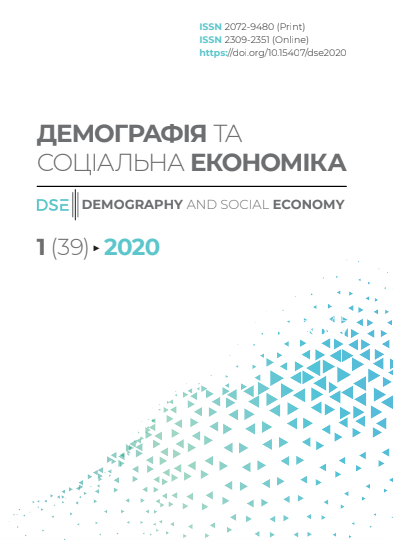CURRENT STATE OF YOUTH ENTREPRENEURSHIP: STATISTICAL AND SOCIOLOGICAL DIMENSIONS
Keywords:
youth entrepreneurship, self-employment, institutional support, statistical indicators, sociological indicatorsAbstract
This study highlights one of the key problems of population employment — the current state of development of youth entrepreneurial self-employment as a manifestation of economic activity in the context of statistical and individual sociological measures in this area. The purpose of the study is a statistical analysis of the many different aspects of this process, which reflects the closest possible real, current state and development of this area of economic activity. The article uses the economic-statistical and mathematical-statistical method to determine the absolute and relative indicators of the level and dynamics of business development. Comparisons, descriptive method, analysis, generalization and induction are applied. On the basis of available statistics, synthesized indicators, empirical sociological research on this issue, the following sides are analyzed: general situational aspects and their tendencies; quantitative dynamics of the development of entrepreneurial self-employment and sociological alternatives to the representation of this process and phenomenon; conceptual aspects of self-employment and informal employment. A separate research segment presents sociological data on the social aspects of youth entrepreneurship, namely: social perception and attitude to entrepreneurial realities; motivational aspects; preferential aspects; socio-problematic, appraisal and segmental aspects. A partial assessment of institutional support for youth entrepreneurship by the state is provided in the context of major problems, appropriate measures to regulate and stimulate it. On the basis of this statistical and sociological analysis, the conclusion on the situation with youth entrepreneurial selfemployment in Ukraine is supplemented; it is characterized by a rather slow rate of development of entrepreneurship among young people due to administrative, legal, financial, organizational problems, namely: lack of complex, first of all, financial-credit, methodological-informational, investment, educational support, as well as systematic analysis and support on national, regional and local levels. The research is also of practical importance for the renewal of socio-economic and socio-statistical parameters of social development.
References:
- AGER — 2018. (2018). Amway Global Entrepreneurship Survey. Kyiv. Retrieved from https://platforma-msb.org/wp-content/uploads/2018/09/AGER-2018-Ukraine-ua_final. pdf [in Ukrainian].
- Statistical collections “Distribution of Ukrainian Permanent Population by Sex and Age” for 2016 (2016). The State statistics service of Ukraine. Kyiv. Retrieved from http://database. ukrcensus.gov.ua/PXWEB2007/ukr/publ_new1/2016/publ2016.asp [in Ukrainian].
- Statistical collections “Distribution of Ukrainian Permanent Population by Sex and Age” for 2017 (2017). The State statistics service of Ukraine. Kyiv. Retrieved from http://database. ukrcensus.gov.ua/PXWEB2007/ukr/publ_new1/2016/publ2016.asp [in Ukrainian].
- Statistical collections “Distribution of Ukrainian Permanent Population by Sex and Age” for 2018 (2018). The State. statistics service of Ukraine. Kyiv. Retrieved from http://database. ukrcensus.gov.ua/PXWEB2007/ukr/publ_new1/2016/publ2016.asp [in Ukrainian].
- The number of FOPs in the country has increased by 4%: the leading computer programming (2019, 16 May). Economic truth. Retrieved from https://www.epravda.com.ua/ news/2019/05/16/647837 [in Ukrainian].
- The SFS calculated the number of individuals — entrepreneurs (2017, 16 September). UkrInform. Retrieved from https://www.ukrinform.ua/rubric-economy/2302824-u-dfspidrahuvali-kilkist-fizicnih-osib-pidpriemciv.html [in Ukrainian].
- The tax disclosed the amount of FAP and the amount of payment of ERUs (2019, 22 Fabruary). RBC Ukraine. Retrieved from https://www.rbc.ua/rus/news/nalogovayaobnarodovala-kolichestvo-flp-summy-1550838862.html [in Ukrainian].
- Ukraine - 2017. Statistical collection (2018). Kyiv. Retrieved from http://www.ukrstat.gov. ua/druk/publicat/kat_u/2018/zb/07/zb_ukraina2017.pdf [in Ukrainian].
- Ukrainians want to give money to start a business Today (2017, 31 March). Segodnya. Retrieved from https://www.segodnya.ua/economics/business/ukraincam-hotyat-davatdengi-na-otkrytie-biznesa-1008367.html [in Ukrainian].
- Statistics from the State Tax Service of Ukraine: during the year 2017 there were 264 thousand FOPs registered (2018, 15 Fabruary). Debit - credit. Accounting News. Retrieved from https://news.dtkt.ua/state/entrepreneurship/47203 [in Ukrainian].
- Over the last two months, 36,000 FOPs ceased operations (2018, 30 January). Oppendabot. Retrieved from https://opendatabot.ua/blog/142-fop-2018 [in Ukrainian].
- Annual Business Climate Assessment in Ukraine: 2016. Analytical Report National and Regional Dimensions (2017). USAID LION. Kyiv. Retrieved from www.ier.com/files/ Projects/2015/LEV/ABCA2017/ABCA2016_full_report.pdf [in Ukrainian].
- Libanova, E., Tsymbal, O., Yarosh, O., & Lisohor L. (2016). Transition to the youth labor market of Ukraine. Results of the International School-to-work transition surveys in Ukraine 2013 and 2015. ILO. Geneva [in Ukrainian].
- Youth of Ukraine - 2017: results of sociological research (2017). Omega Center for In dependent Sociological Research. Kyiv [in Ukrainian].
- Topical Issues of Achieving Decent Employment for the Youth of Ukraine: An Analytical Note. (2015). Ptoukha Institute for Demography and Social Studies of the National Academy of Sciences of Ukraine. Kyiv. Retrieved from http://ipq.org.ua/upload/files/files/06_ Biblioteka/05_Komentari_ekspertiv/Analitika_SWTS-Ukraine.pdf [in Ukrainian].
- Employment by sex, type, and age groups in 2017 (n.d.). Retrieved from http://ukrstat.gov. ua/operativ/operativ2017/rp/eans/XLS/znsmv2017xls_u.zip. [in Ukrainian].
- Informally employed population by sex, place of residence and age group in 2017 (n.d.). Retrieved from http://ukrstat.gov.ua/operativ/operativ2017/rp/eans/XLS/nzn_smpvg_ 2017_u.zip [in Ukrainian].
- Trifonov, M. (2015, 13 May). Informal employment of the population of Ukraine: quantitative and qualitative measurements. Retrieved from https://commons.com.ua/ru/neformalnazajnyatist-naselennya/ [in Ukrainian].
- Youth of Ukraine-2015 (2015). Ministry of Youth and Sports of Ukraine. HFC Ukraine. Kyiv. Retrieved from https://ukraine.unfpa.org/sites/default/files/pub-pdf/-%D0%A3% D0%BA%D1%80%D0%B0%D1%97%D0%BD%D0%B8%20-%202015 [in Ukrainian].
- Education in Ukraine: basic indicators. (2018). Information bulletin. Ministry of Education and Science of Ukraine. DNU “Institute of Educational Analytics”. Kyiv. Retrieved from https://mon.gov.ua/storage/app/media/nova-ukrainska-shkola/1serpkonfinformatsiyniy-byuleten.pdf [in Ukrainian].
- Dmytruk, N., Padalka, H., Tilikina, N., & Kirieiev, S. (2018). Youth of Ukraine - 2018. Results of sociological research. SE Editing of information Bulletin “Official Bulletin of the President of Ukraine”. Kyiv. Retrieved from http://www.dsmsu.gov.ua/media/ 2019/01/08/9/Doslidjennya_broshyra.pdf [in Ukrainian].
- Build your own (n.d.). Retrieved from: https://buduysvoe.com/node/107893 [in Ukrainian]
Downloads
Published
How to Cite
Issue
Section
License
Copyright (c) 2020 Євген Сірий

This work is licensed under a Creative Commons Attribution-NonCommercial-NoDerivatives 4.0 International License.


